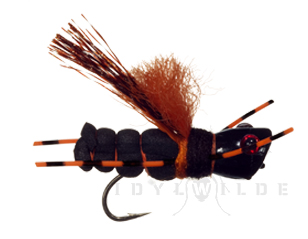I get asked the question all of the time what’s my favorite place to fly fish?
Some may find it weird but I always have a hard time answering that question. I’ve had the opportunity to fly fish so many unique and beautiful places in my life that there’s no way I could settle on one place as my sole favorite. If you’re wanting a quick answer, a much better question to ask me would what’s my favorite hatch to fly fish. I’d have no problem giving you a straight answer on this question. If I could spend all my time traveling around and planning out my fly fishing for one specific hatch it would be for the periodic cicada hatches that occur along the Eastern United States.
In 2000, I got to experience fly fishing the periodic cicada hatch for the first time in my life. The hatch happened to occur around my home waters and for one and a half months straight, I got to experience the heavenliness of strictly fishing giant foam cicada patterns on the surface. I’d never seen a hatch have so much effect on my resident fish and I’d never witnessed such epic dry fly fishing. Day after day, my buddies and I landed trophy after trophy on cicadas. We also were educated on just how many big resident fish we really had swimming around in our home waters (cicadas get all fish to come out and feed). The amount of food that a periodic cicada hatch provides an ecosystem is insane. Some scholars claim that the food value of a periodic cicada hatch is equivalent to an Alaskan salmon run. Have no doubts, the cicada has the power to convince the smartest and biggest fish to drop their guard and come out and feed for several weeks with total recklessness 24 hours a day.
You don’t have to be an expert fly fisherman to find success fishing a cicada hatch. It’s probably the least technical hatch I’ve ever fished. All you need to do is get yourself a good cicada fly pattern and fish it on waters where the hatch is occurring. The only thing you really need to know is go big with your tippet (2X-3X) and don’t be too quick on your hook sets. Below are some of my favorite cicada patterns.
Cicada Fly Patterns – My Favorites
If I could only have one cicada in my fly box this is the one it would be. It’s super durable, floats like a cork and has a unique popper style head that gives you the ability to call the fish in from long distances. I give props to the creator of this fly who hit the center of the bulls eye. Yeager’s Neversink Cicada Popper
Looking for a cicada pattern that has a strong wide gap hook suitable for tackling a wide range fish species? Brasso’s Babygirl Cicada fits the bill and would be my number two choice among all the cicada patterns out there.
This super realistic cicada pattern from Montana Fly Company is just too cool not to have in your fly box. If you do happen to find yourself in a situation where the fish are being really picky, this pattern is sure to get the job done for you. Try fishing it on the calmer sections of water where the fish have the luxury of time to examine your cicada pattern to the real thing. I like to hit mine with a black sharpie marker to match it to the naturals better.
I couldn’t round out my cicada pattern list without providing at least on Dave Whitlock recipe. He’s a personal hero of mine, and his periodic cicada caught me a lot of big fish during the year of 2000 on my home waters. This spent cicada pattern is dynamite. You will get some twist from the spent wings so make sure you go heavy with your tippet and limit false casting.
That’s my fly list to get you ready if you’re planning on fishing a periodic cicada hatch. This year, the “Brood II” cicadas will be hatching by the billions from Georgia to New York. I’ve already heard reports of the hatch occurring in some areas. Take advantage of this rare hatch if you can. Several years go by in between hatches. There’s lots of maps and information out there to help you figure out where the cicadas will be hatching. The hatch is triggered by soil temperature. Most scientists agree that when soil temperatures reach 64 degrees (approximately 8 inches below the ground surface) that’s when the cicada larva will emerge from their dens. We hope to see you on the water during the amazing fishing and rare hatch.
Keep it Reel,
Kent Klewein Gink & Gasoline www.ginkandgasoline.com hookups@ginkandgasoline.com Sign Up For Our Weekly Newsletter!





Kudos for this article on the Cicada hatch and your fun and success in 2000. I too , while bass fishing with poppers,discovered everything in the river would occationally take the bass popper. Realizing what was happening I went home and tied a few rough looking cicada flies and had the best fly fishing I’d ever had for a number of species in about a three week period. The same Brood V 17 year species ,which happens throughout my area next year ,will pose a big decisions ; what species to target.as everything comes up and eats them. It’s a pretty sight to see a 20+ pound carp come up and because of their under slung mouth,have to roll to suck the bug in.I can’t wait and even though I have a box full of cicada flies,will continue to tie for the next 11 months or so. Their emergence will happen when the ground temperature reaches 64 degrees 8″ deep in the soil..
Great article. Clark’s Cicada designed by NZ legend Clark Reid is a cracker of a pattern too. Another Umpqua fly. Go the deer hair!